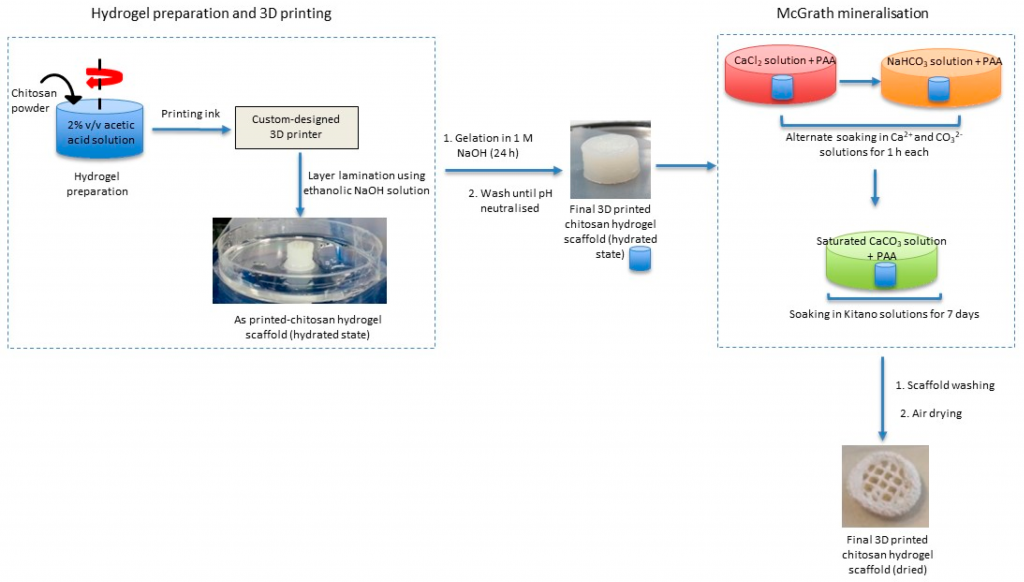Researchers from New Zealand and Australia have been looking into using natural elements as inspiration for 3D printing in bone grafts, detailing their findings in ‘Towards the Development of Artificial Bone Grafts: Combining Synthetic Biomineralisation with 3D Printing.’ Authors Mima Kurian, Ross Stevens, and Kathryn McGrath outline techniques centered around nacre (known to most of us as mother-of-pearl). Now known as the McGrath method, the use of synthetic biomineralization allows scientists to 3D print artificial scaffolds with chitosan hydrogel used for ink.
So far, the McGrath method takes place in a 3D printer customized by the research team, showing great potential for use of 3D compartmentalized polymer-mineral composites. Nacre is chosen as a material because of its biological importance overall, which has made it the subject of other studies before. In this case, the researchers are studying the qualities of biomineralizaton in nacre as they create chitosan-calcium carbonate composites that are 3D printed. Nacre’s strength is similar to natural bone, making it a suitable area of study for the researchers as they seek further progress in the realm of artificial bone grafts.
The researchers have developed chitosan-based scaffolds that are 3D printed and mineralized, with the technique they have created allowing for ease in creating the desired shape, size, and connectivity, along with geometry and ‘orientation of the pores.’ The research has also catapulted into further studies related to:
- Tissue regeneration
- In vitro organ development
- Bone fixtures
- Replacement materials
- Anatomical models for drug screening

The experimental procedure, from left to right: preparation of the hydrogel printing ink and printing of the scaffold; gelation and neutralisation of the scaffolds; mineralisation.
In this study, the researchers use the McGrath method to create mineral formation in 3D printed scaffolds, with their structural integrity evaluated in examining different concentrations of chitosan hydrogels.
“As the chitosan concentration was increased more continuous strand formation and greater shape retention were observed,” stated the researchers. “If the chitosan concentration was too high, the required pressure to induce flow and achieve an appropriate viscosity was beyond the range available in the printer used here.”
Overall, the research team discovered that such composites are improved by controlling features such as porosity, architecture of scaffolds, polymer density, mineral content and more. They also noted the importance of strength in adhesion of layers:
“The layers of printed hydrogels were laminated to each other; the adhesion is strong enough to avoid layer slippage hence forming a stable 3D structure,” stated the researchers. “Ethanolic sodium hydroxide, used to laminate the printed layers to each other, partially deprotonates the amine groups in the printed hydrogel layers such that printed layers do not flow and adhere to each other with appreciable adhesion.”

On the left are optical images of non-mineralised 3D chitosan hydrogel-based scaffolds in hydrated or dehydrated states. On the right are corresponding electron microscope images. 3D chitosan hydrogel-based scaffold in (a) hydrated; (b) critical point-dried; (c) air-dried; (d) freeze-dried. Scale bar is 1 μm unless otherwise mentioned.
This research project resulted in 3D printed scaffolds that were structurally stable, comprised of macropores, micropores, and nanopores. While varying states of dehydration were explored, both freeze-dried and critical point-dried scaffolds preserved hydrogel porosity as desired, without shrinkage.
“The as-printed chitosan hydrogel-based scaffolds were mineralised via the McGrath method in the presence and absence of PAA as the crystal growth modifier,” concluded the researchers. “The printed macropores and the layer-by-layer build of the 3D chitosan scaffolds increased the extent of mineralisation achieved in the final composite.”
“By using 2.5% w/w PAA and modifying the McGrath mineralisation process to perform the mineralisation when the chitosan hydrogel scaffold is in its hydrated state, pancake-like calcium carbonate formation, which is in intimate association with the hydrogel matrix, as obtained previously on 2D thin films, is replicated with 3D chitosan hydrogel-based scaffolds. However, more research is required to obtain an optimal distribution of this particular morphology throughout the 3D printed scaffold.”
A surprising number of high-tech advances have taken their lead from the inestimable power of nature. Humans are continually fascinated with the most simple to the most complex facets of the outdoors, the animal kingdom, and the many details we encounter when outside in the fresh air or exploring biology and science. In 3D printing, we have followed stories of scientists, designers, and engineers creating everything from liquid crystal polymers to armor inspired by fish scales and customized exobiology shoes based on nature.
What do you think of this news? Let us know your thoughts! Join the discussion of this and other 3D printing topics at 3DPrintBoard.com.

SEM images of 3D chitosan hydrogel-based scaffold mineralised via the McGrath method (a–c) in the absence of polyacrylic acid (PAA), and (d–f) in the presence of 2.5% w/w PAA with respect to the dry weight of the chitosan scaffold used; (e) pancake-like CaCO3 crystallites (f) pancake-like crystallites with globular moieties growing on the surface. Scale bar for images on the left-hand side is 100 μm and for those on the right-hand side is 10 μm.
[Source / Images: ‘Towards the Development of Artificial Bone Grafts: Combining Synthetic Biomineralisation with 3D Printing.’]

98 Replies to “Researchers Examine Potential for Synthetic Biomineralization in 3D Printing Bone Grafts”
Comments are closed.